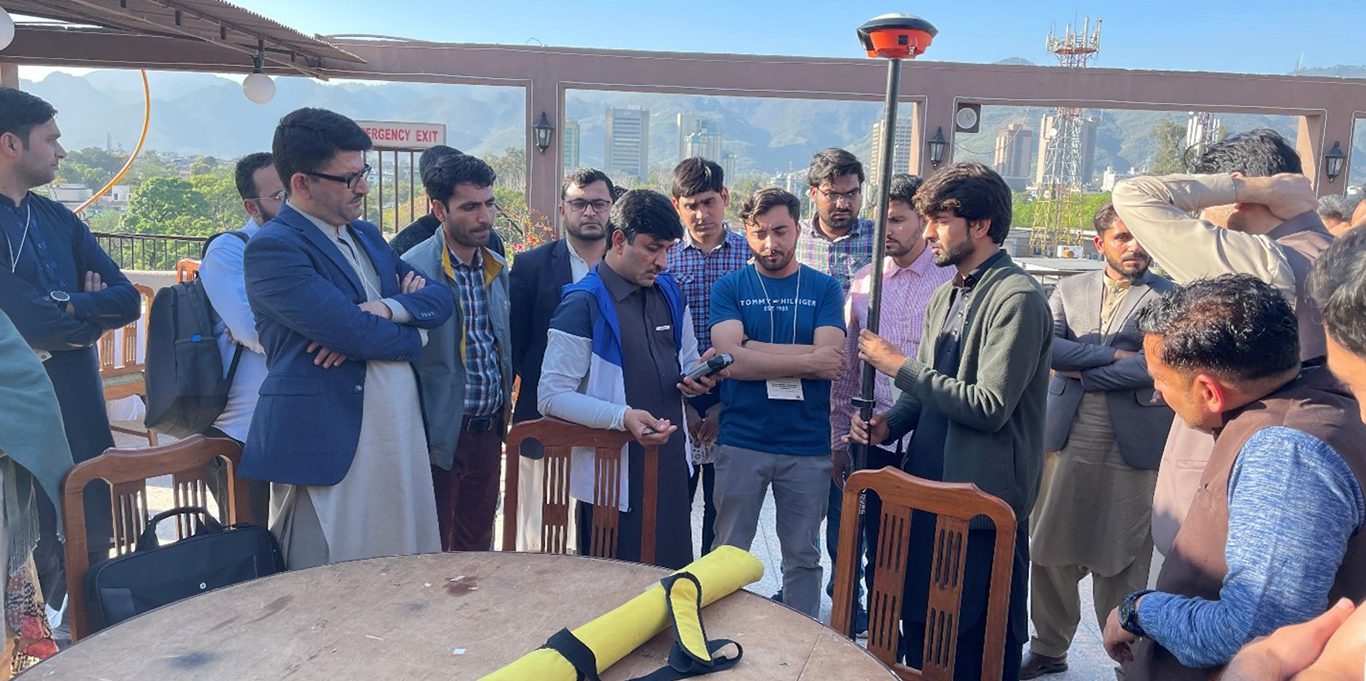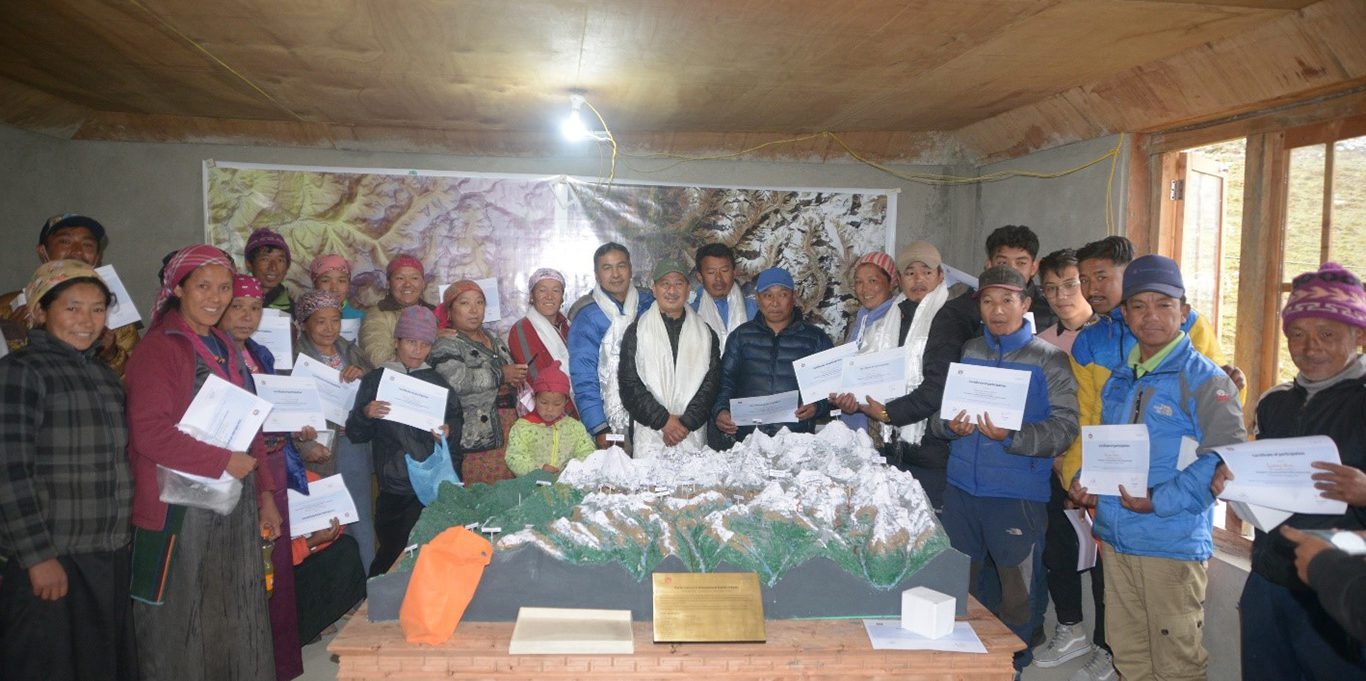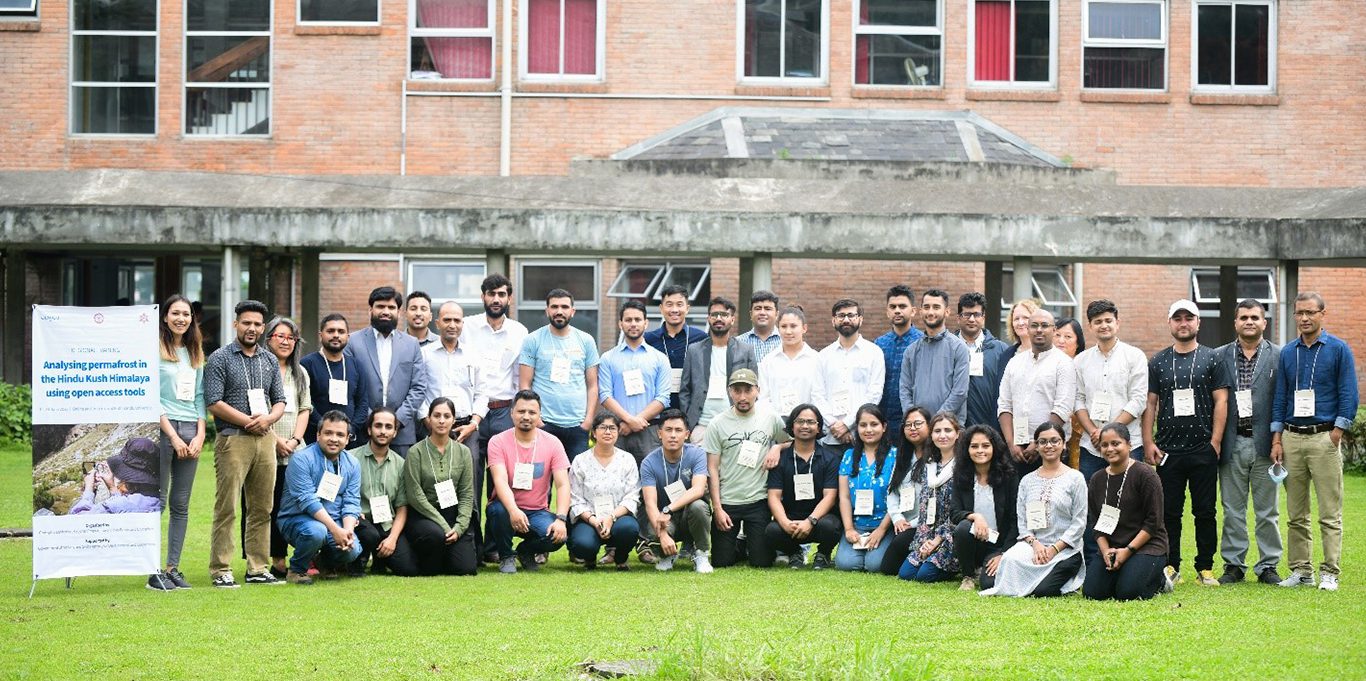This site uses cookies, as explained in our terms of use. If you consent, please close this message and continue to use this site.
 Training lead Sher Muhammad (centre, blue/white jacket), Remote Sensing Specialist, ICIMOD with training participants.
Training lead Sher Muhammad (centre, blue/white jacket), Remote Sensing Specialist, ICIMOD with training participants.
One of our primary objectives is to improve the capacity of our partners to monitor cryosphere changes in the region. We have been working with our partners since 2011 to build their capacities and commence long-term cryosphere monitoring activities. The training programmes we organise are targeted to specific countries or at the regional level. They focus on collecting, analysing, and using glacier, snow, and permafrost data. Here is a summary of the trainings we organised in from January–June 2022.
As a continuation of our capacity building programmes in Pakistan, we collaborated with the Pakistan Agricultural Research Council (PARC) to organise a training on remote sensing and field-based glacier and snow monitoring targeting early-career researchers and students in the country. It was aimed at building the capacity of students and professionals, especially in parts of the region where there is little or sparse glacier and snow monitoring. We previously carried out trainings on glacier monitoring in Pakistan in 2019 and 2020. Due to the strong interest of partners and early career researchers, we continued organising such trainings.
This year, 36 participants from 22 partner agencies attended the training. Additionally, 18 participants were selected from more than 550 applicants through a competitive, open call. The training explored free and available remote sensing data and software for mapping and monitoring glaciers, glacier lakes, and snow, and covered field-based glacier monitoring techniques using GPS and GPR with outdoor exercises.
The participants share their experiences:
“A multi-method scientific approach based on ground and satellite-based remote sensing techniques such as GPR and SAR, along with field evidence, is necessary for hazard mitigation. This training facilitated a close interaction among the participants for their future work on glacier and snow research studies in Pakistan. It highlighted the importance of having relevant skills in producing the latest data.”
– Muhammad Younis Khan, University of Peshawar
“Researchers in Pakistan have limited access to freely available datasets and tools for glacier monitoring. This training programme addresses this issue by teaching students and professionals how to generate and analyse data independently.”
– Hammad Ali, Pakistan Water and Power Development Authority
“This training was very relevant to our mountain areas. The learning and exposure from this training can be applied to mitigate problems posed by global warming, which ultimately triggers GLOFs.”
– Dostdar Hussain, Karakoram International University

Langtang Valley is a popular tourist destination in Nepal and has been the focus of ICIMOD’s cryosphere research since 2011. The 2015 earthquake destroyed the village, and the COVID-19 pandemic led to a decline in the number of tourists visiting the valley.
A participatory 3D model (P3DM) of the Langtang Valley provides valuable information for tourists. The model depicts land use features, viewpoints, landslide hazard areas, cultural sites, and trekking routes. The model sits in the Gosaikunda Rural Municipality, Ward-4 Office and was constructed at the request of the former Ward Chair. The model was to be handed over to the Langtang community during the Visit Nepal 2020 campaign to promote tourism in Langtang Valley, but this was delayed due to the pandemic.
The P3DM was constructed collaboratively with community members and Langtang National Park. Our experts also trained community members. The features in the model are based on local spatial knowledge and community members can update the model and add new features as needed.
A total of 25 community members ranging from hotel owners, trekking guides, painters, students, and homemakers from Langtang attended the training. About 50% of the participants were women, making it an excellent gender-balanced participation.

Our annual R training in June 2022 explored open-source tools to analyse permafrost – the third pillar of the cryosphere – and the least studied in the HKH region. The training has become extremely popular among early-career researchers and concerned government agencies, with this year’s application call receiving over 300 applicants. Only 15 of them were accepted.
Building on previous training workshops on snow and glacier monitoring, this training introduced permafrost to the participants. The participants learned about field monitoring, sensor technology, and how to use the data obtained for modelling permafrost distribution. They also learned to access and process freely accessible data using Google collab, a cloud-based Jupyter notebook that is free to use and can be easily transferred between researchers. The training helped boost the participants’ confidence in improving existing regional and global permafrost map that often does not reflect local variations in topography and climate due to coarser spatial resolution.
The training participants reflect on their experiences:
“In Nepal’s case, hydropower development has been concentrated in the mid hills until now. With limited opportunities in the mid-hills, such projects are moving into high mountains. As such big infrastructure moves up, we must take permafrost research as one of the prerequisites for development.”
– Prashant Bhatta, Earl Career Researcher, Nepal
“In our centre, we conduct research on hydrology and glaciology in the context of climate change. Our work focuses on snow and glacier, but permafrost is the missing link. This training was very useful in introducing the permafrost monitoring aspect, and I look forward to including permafrost research in the work of our centre.”
– Amjad Masood, Global Change Impact Studies Centre, Pakistan
“Permafrost, one of the important components of the cryosphere, is under research in Bhutan; I understand the need to include permafrost research in Bhutan as well.”
– Tshering Duba, National Centre for Hydrology and Meteorology, Bhutan
“I am PhD student, and my current research is on permafrost. Machine learning and open access tools I’ve learnt from this training will help progress my research.”
– Ishita Pradhan, IIT Mandi, India

Stay up to date on what’s happening around the HKH with our most recent publications and find out how you can help by subscribing to our mailing list.
Sign Up